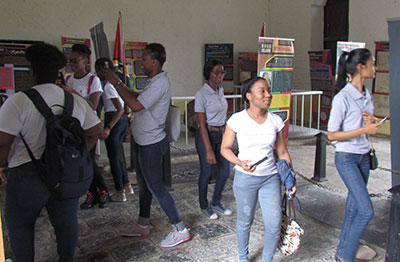COUNTRIES in many parts of the world celebrated International Museum Day on May 18. According to studies this has been happening since 1977, even though museums have been in existence for over 2000 years ago.
Museums are usually set in place to carry out very important functions such as garnering information through research; preserving such information for display and the edification of people. The museums also collect artefacts of cultural or historical significance, which are carefully stored and used to raise the awareness of people for various reasons.
International Museum Day is one such occasion when people are encouraged to visit museums so that they may be made aware of historical facts and cultural events, most of which happened in the past.

In an effort to inform and educate the public, the Ministry of the Presidency, Department of Social Cohesion, Culture, Youth and Sport, through the National Trust of Guyana organised a tour, which included teachers in training, students of the University of Guyana and other officials to a visit of the Court of Policy Hall and Fort Zeelandia at Fort Island.
Two trips had to be made in order to accommodate the number of persons invited since the teachers and others were selected from different locations around Guyana. Though the day turned out to be rainy, those in attendance showed tremendous interest in what was being shown to them; even with the rain, some of them wanted to stay on the island for a longer period in order to see and learn more than time and the weather would have allowed.
REFLECTIONS AT THE COURT OF POLICY
Looking around and seeing artefacts, reading brief notes about slavery, thinking about what took place, connecting with facts and feelings were all terrible emotions which can be stirred up from the reflection of what took place so many years ago. But there should be no bitterness, probably sadness, with a stirred determination to make life better.
The official from the National Trust during his presentation explained methods the ‘masters’ used to manage the then slaves within the building; showed and described height and thickness of the walls – the sturdiness; the solidness of even the floor with its huge tile-like concrete slabs laid out in a manner that made the place show cruelty. Though, under instruction, they were created by the very slaves who were subsequently made to endure the hardships of what came with the building.
The Court of Policy Hall was built for, among other things, to house slave ‘prisoners’ who ‘misbehaved’. They were tried and sentenced there – sometimes to face the ultimate condemnation, which was death.
HUBU CREEK, ESSEQUIBO
The Court of Policy Hall and Fort Zeelandia are located at Fort Island – an island, which is a piece of land surrounded by water and it is strategically located at the mouth of the Essequibo River. The Dutch therefore saw the location as ‘tactically located’ for purposes of defence if needed.
After driving from Georgetown, the island can be reached by speedboat, using the Parika route, or by driving all the way to Hubu Creek – a place busting with economic activities. Hubu is five miles above Parika, after which it takes an approximately 10-minute trip by speedboat to travel across the Essequibo River to the small stelling at Fort Island to get to the museum.
However, rain or no rain, once on the island, especially during the time of the actual visits to the museum, the enthusiasm of the visitors did not wane for one moment. People wanted to see and learn as much as they could and so they did.
On the return trip back to the various locations many teachers and students spoke about the hope of being able to benefit from other organised trips to other museums, so that they may be further informed and educated, thus being able to share with the children under their charge, as well others. (mercilinburke2017@gmail.com)



.jpg)








